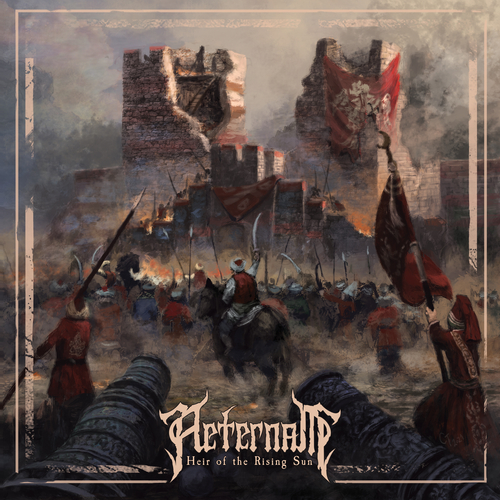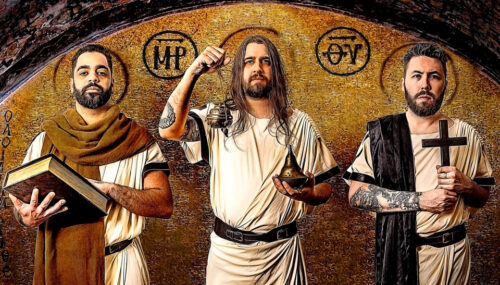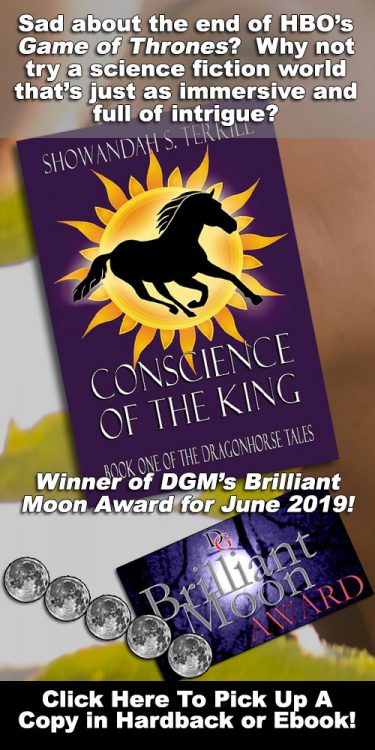
Band/Artist: Aeternam
Release House: Rockmark Records
Genre: Symphonic Death Metal
One Sentence Synopsis: The new full-length album from Canadian symphonic death metal band Aeternam.
Series: Standalone
Single/EP/Album: Album
Release Date: September 2, 2022
Estimated Length: 47 minutes
MSRP: $10 (digital); €14,90 (CD)
Website: Click Here
Music Video: Click Here
Purchase Site: Click Here
Reviewed By: Kastrophylax
Final Score: 5.0 Moons (out of 5.0)
Hailing from Quebec, Canada, Aeternam formed around 2007. Having been noticed early on in the Canadian metal scene, the band released their first album, Disciples of the Unseen, in 2010, with the major metal music label Metal Blade. With this release, the band revealed the musical and lyrical themes that would take center stage in their creative oeuvre. Using the philosophical and theological imagery of Gnosticism, Kabbalism, and the Egyptian and Mesopotamian pantheons, Aeternam weaves a lyrical tale of warring gods and the darkness of the occult. Musically, the band’s solid rhythmic core of drummer Antoine Guertin is immediately apparent in their debut album, as is the Middle Eastern flavor of the riffing and soloing of Moroccan guitarist Achraf Loudiy. Aeternam would go on to explore similar territory in their next three albums: Moongod (2012) critiques the Abrahamic religions through the prism of pre-Islamic Arabian polytheism; Ruins of Empires (2017) examines the frail temporality of ancient world empires; Al Qassam (2020) employs mythological imagery from different historical periods and civilizations. The band’s latest release—Heir of the Rising Sun (2022)—represents the pinnacle of their musical and storytelling prowess. For this review, I will be focusing on not just the usual musical and lyrical elements, but also the fascinating history from which Aeternam draws inspiration in this metal tour-de-force.
Theme
Folk Interludes
Heir of the Rising Sun opens with the track “Osman’s Dream.” The listener is treated to a poem attributed to the founder of the Ottoman dynasty of the Turks in which he prophesied the conquest of Constantinople, the capital of the Byzantine (or Eastern Roman) Empire, in 1453 AD. The accompanying music sets a pensive tone, with Middle Eastern instruments such as the Turkish bağlama strumming softly, and building in pace and intensity until the band and orchestration come in. There are several interludes on the album that feature folk instruments and singing.
music sets a pensive tone, with Middle Eastern instruments such as the Turkish bağlama strumming softly, and building in pace and intensity until the band and orchestration come in. There are several interludes on the album that feature folk instruments and singing.
“Kasifi’s Verses,” appearing in the middle as an intermission, quotes a Persian poem recited by Ottoman Sultan Mehmet II “the Conqueror” when he entered Constantinople after the siege. It is filled with traditional instruments like the oud and various flutes and wind instruments. The arrangement is tastefully done and replicates the sound of Ottoman court music from the early modern period. Aeternam assembled an ensemble of talent to record these interludes and it adds to the overall “epic” feel of the album.
“Akhatist Hymn,” the second to last track, features a choral ensemble chanting, in Greek, one of the most holy hymns of the Eastern Orthodox Church (the Byzantines were Orthodox Christians). The hymn was originally composed in the sixth century AD in honor of the Virgin Mary (the Theotokos or “Mother of God”) as patron and protector of Constantinople. It received an additional line celebrating what was viewed as her divine intervention to save the city during a siege by a joint force of Persians and Avars in 626 AD. It provides an emotional contrast to the subject matter of the final track: the fall of Constantinople and the death of the last Byzantine emperor.
Main Tracks
“Beneath the Nightfall” describes, from Mehmet II’s point of view, the tremendous task of laying siege to and conquering one of the most well-defended cities in history (it was surrounded by massive walls on all sides). The lyrics convey the sultan’s sense of urgency and his perception of his role as one of destiny. Aeternam includes a couple lines in the lyrics about the ominous portents that occurred right before the siege, a feature which demonstrates the amount of research and attention to detail they put into this project. Musically, in this song, the band applies many of the methods they have honed in past releases: harsh/clean vocal tradeoffs, lush orchestration, thundering blast beats by the drums, and folk instrumental breaks.
The next four tracks travel back in time to chronicle important events from Byzantine history before the fall of the Empire. “Irene,” for example, focuses on the actions of an eighth-century empress who ended the period of “Iconoclasm” and restored the religious practice of icon veneration for which Orthodox Christianity is known. Unfortunately, after this, her reign descended into intrigue and internecine strife, and it took the life of her son and heir Constantine VI. Irene’s reign—and life—ended in exile. This track has fantastic clean vocal and guitar melodies. These uplifting, almost joyous, melodies are tempered by an atmospheric folk instrument interlude that signifies Empress Irene’s misfortunes. Also, the driving orchestral melody of the final track (“The Fall of Constantinople”) makes a brief appearance, foretelling future ominous events.
Example of Byzantine icon
“Nova Roma” opens with sound effects and a historically famous quote by the sixth-century Emperor Justinian. It describes his elation after constructing the great Byzantine cathedral known as the Hagia Sophia (Holy Wisdom) in Constantinople. Once again, Aeternam alternates harsh and clean vocal lines to great effect, while the lyrics illustrate the decades of war and hardship the Byzantines (and their enemies) endured as part of Justinian’s plan to reconstitute the old Roman Empire. This song, similar to “Irene,” has beautifully expressive vocal, guitar, and orchestral melodies. A proggy instrumental section provides a great transition between the bright and dark thematic changes of the song.
“Where the River Ends” tells the story of the Vikings’ seaborne attack on Constantinople in the middle of the ninth century. As one might expect, the feel of the song is reminiscent to songs of the “Viking metal” subgenre. There are plenty of gruff vocal lines exhorting Northmen to battle, anthemic choruses invoking pagan gods, and furious riffing supported by blast beats from the drums. Historically, though, the Byzantine navy defeated this fearsome Viking foe when they burned their fleet with the secret “Greek Fire” weapon. The Vikings subsequently became trading partners with the Empire and provided bodyguards for the Byzantine emperor.

Aeternam in Byzantine attire
“The Treacherous Hunt” describes one of the darkest moments in Byzantine history. The Fourth Crusade, which was launched from Western Europe to attack the Islamic sultanate in Egypt, became embroiled in political distractions and the search for financial support to pay off debts owed to the Venetians for naval transport. As a result, the expedition was diverted to Constantinople in a frantic search for money. The crusader forces found alternate ways to circumvent the defensive walls and proceeded to ransack the city for several days. The song lyrics recount the tragedy that unfolded in 1204 AD: Christians burning homes and desecrating churches of other Christians out of greed and ignorance. The orchestration and Latin chants are especially effective in translating the tragic subject matter of this track.
The album and its historical journey reach a spectacular ending with “The Fall of Constantinople.” Aeternam expertly combines all the musical and lyrical tools mentioned above in a ten-and-a-half-minute epic recounting the conquest of Constantinople by the Ottoman Turks in 1453 AD. Thematically, it functions as a bookend to the first couple tracks of the album: while those tracks see the conquest from the Turks’ point of view, the final track is from the perspective of the last Byzantine emperor, Constantine XI Palaiologos. He perished in heroic fashion fighting the Ottoman troops as they poured through the breach in the city walls made by the Turks’ massive gunpowder artillery pieces. The frantic, driving pace of the track eventually subsides into an eerie yet plaintive rendition of a traditional Greek folk lamentation of the event.
Presentation
With Heir of the Rising Sun, Aeternam has shown definitively that they have perfected their epic musical formula. With tremendous balance, they blend the harsh vocals, heavy riffs, and technical drumming of death metal with beautiful orchestration and folk instrumentation. “Beneath the Nightfall,” “Irene,” and “Nova Roma” contain particularly expressive and memorable melodies. “The Fall of Constantinople” is a breathtaking epic full of raw emotion and musical twists and turns.
Looking at the album’s lyrics, it is apparent in most of the songs that the band did their research with care and attention to detail. The musical themes and descriptive lyrics transport the listener on an exhilarating journey through the historical events that comprise the album’s subject matter.
I want to compliment the band’s handling of Byzantine history. Indeed, this history has its fair share of both positive—and rather ugly—events that present a complicated task to translate into music. Although Aeternam’s lyrics in previous albums have been hostile towards traditional religion (especially Christianity and Islam), they have refined their approach here, indicating maturity in their songwriting. Instead of hijacking historical and mythological source material to condemn religion and tear down institutional authority, Aeternam has simply and poetically provided a medium to amplify the history’s natural storytelling power.
Audience Fit
This recording potentially has great appeal to a wide audience. Fans of the symphonic, power, and progressive metal subgenres will find something to latch onto in many of the tracks. Also, listeners who enjoy video game and movie soundtracks will appreciate the depth of the orchestration and folk instrumentation throughout each of the songs. Finally, history lovers will be impressed that a band has taken an interest in the rich, yet often neglected, subject of the Byzantine Empire.
Closing Thoughts
If you would like to take a musical time machine back to an epoch of heroism, grandeur, and savagery, this record will open the door and fasten your seatbelt for you. If you would like a poetic, yet “readable”—that is “listenable”—introduction to Byzantine and Ottoman history, this album will be your guide. Finally, if you can imagine a soundtrack that will tell you all about a historical epic film that was never made, Aeternam’s Heir of the Rising Sun will provide you with that listening experience!
Theme: 5.0 Moons (out of 5.0)
Presentation: 5.0 Moons (out of 5.0)
Audience Fit: 5.0 Moons (out of 5.0)
Final Score (not an average): 5.0 Moons (out of 5.0)


